The Life And Times Of Legendary Independent Watchmaker Derek Pratt
Derek Pratt (1938 – 2009) was born in Orpington, Kent in the South of England, and spent his childhood interested in any and all mechanical objects.
He was first educated at Beckenham Technical School – where he met Derek Goldsmith, with whom he would later design a thermostatic mixer valve, which they sold to Aqualisa. In 1956 he began learning watchmaking at the National College of Horology in London, doing a three-year course as an apprentice of Smith & Sons.
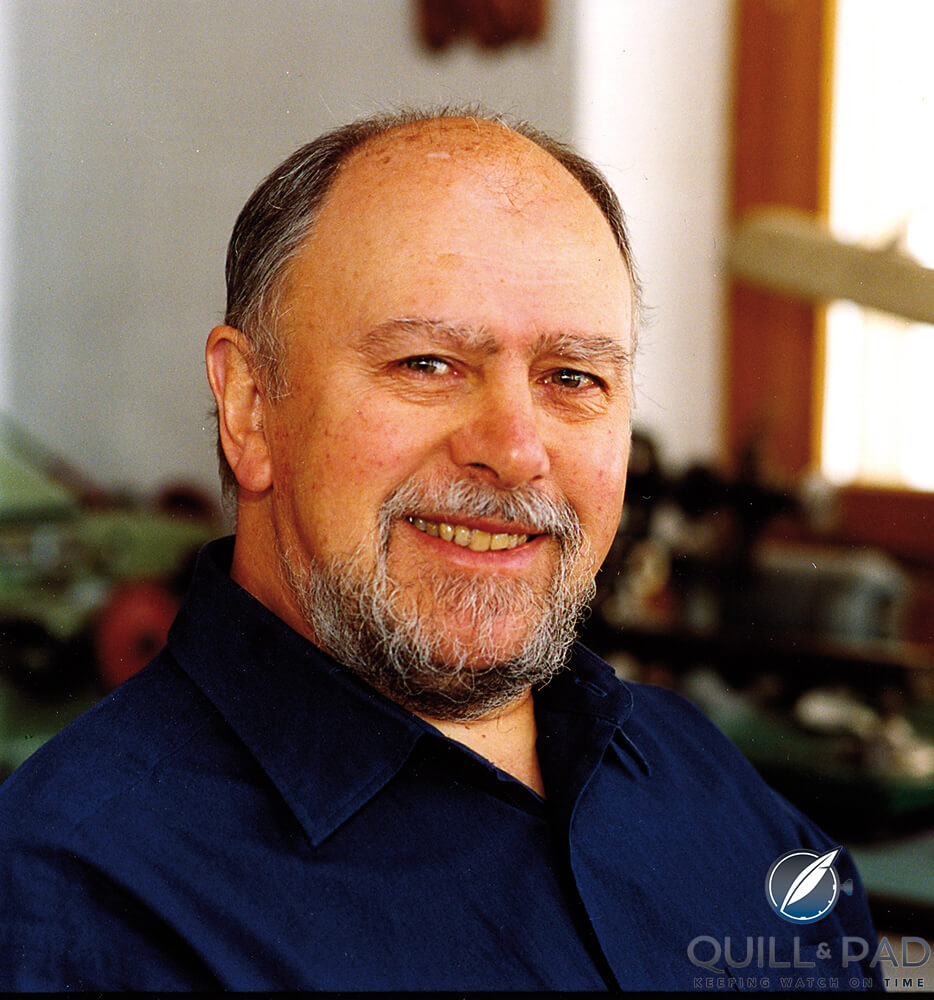
Derek Pratt
Though he was a top student, he left the school without completing his exams. As longtime friend and noted English watch journalist and author Timothy Treffry explained in the introduction to the proceedings from the British Horological Institute’s Derek Pratt commemorative seminar on September 18, 2011, “Traditionally, and when he embarked on the course, final-year students had completed a pocket watch, finishing and casing an ébauche. This project was suddenly changed to one on instrumentation. Derek refused to accept the change.”
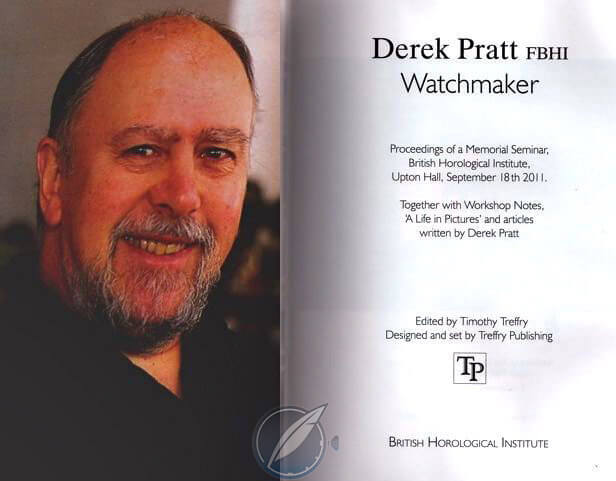
Proceedings from the British Horological Institute’s Derek Pratt commemorative seminar held on September 18, 2011 and edited by Timothy Treffry
In 1965, work with the school’s former director of horology, R.A. Fell, on a black box clock for aircraft as well as micro-soldering devices took him to Switzerland. He also worked as restorer and on the development of chronometers and early iron clocks. Pratt ended up spending the rest of his life in Switzerland.
He started his freelance career as watchmaker and restorer working on complex historical timepieces, most of which came to him through Peter Baumberger, who at that time sold antique timepieces.
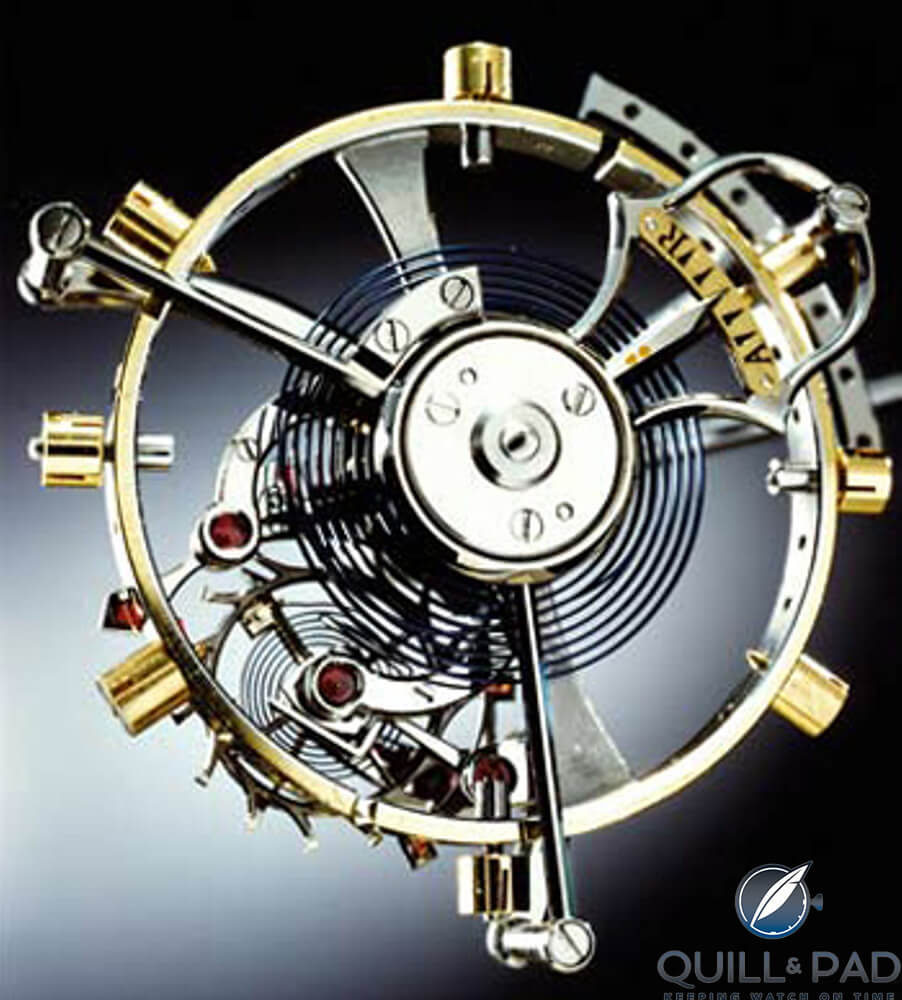
The tourbillon with integrated remontoir from Urban Jürgensen’s Pocket Watch No. 1 by Derek Pratt
When Baumberger took over Urban Jürgensen in 1979, Pratt became consultant and technical director to the brand. In fact, he was a driving force behind the horological innovation during the Baumberger era, which ended with the deaths of both men (Pratt in 2009 and Baumberger in 2010, just eight months later).
Pratt worked on Urban Jürgensen’s Pocket Watch No. 1 for 4,300 hours between 1979 and 1982. This was a skeletonized pocket watch tourbillon featuring a unique constant force system and dead beat seconds. This watch also marked the first time a remontoir had been integrated into the tourbillon mechanism. This watch sold at Christie’s Geneva in 2008 for 315,000 Swiss francs; it was the first time it appeared at auction.
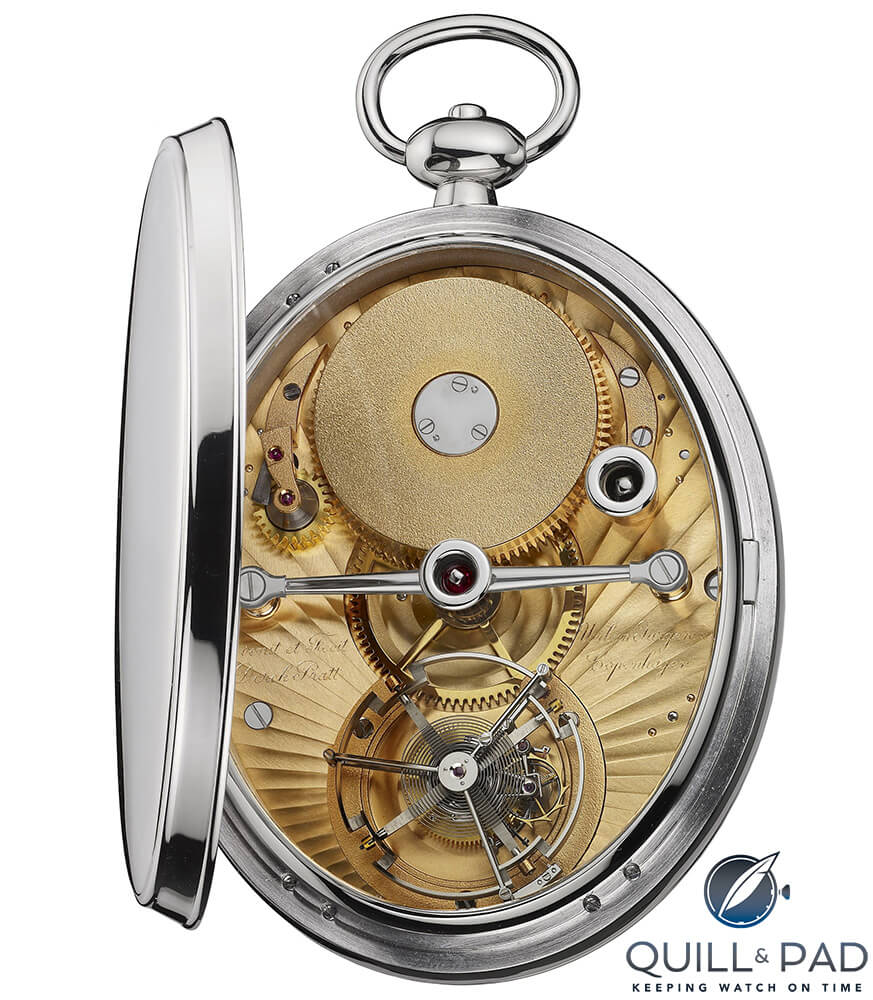
The rear view of the Urban Jürgensen oval tourbillon pocket watch from 1991 by Derek Pratt reveals the remontoir tourbillon with spring detent escapement; this movement is wound by key
Perhaps Pratt’s most famous pocket watch, however, is the Urban Jürgensen oval pocket watch with flying tourbillon, remontoir, detente escapement, power reserve, and Réaumur scale, three of which he completed between 1987 and 1992. Each watch required an incredible 4,000 hours of work. Pratt even made the oval case, beautiful guilloché dial, and shaped the crystal.
This timepiece, a perfect example of how complete Pratt’s skill and knowledge were, was an homage to some of the most important watchmakers of all time, cornerstones in historical watchmaking like Abraham-Louis Breguet, John Arnold, and Professor Alfred Helwig,
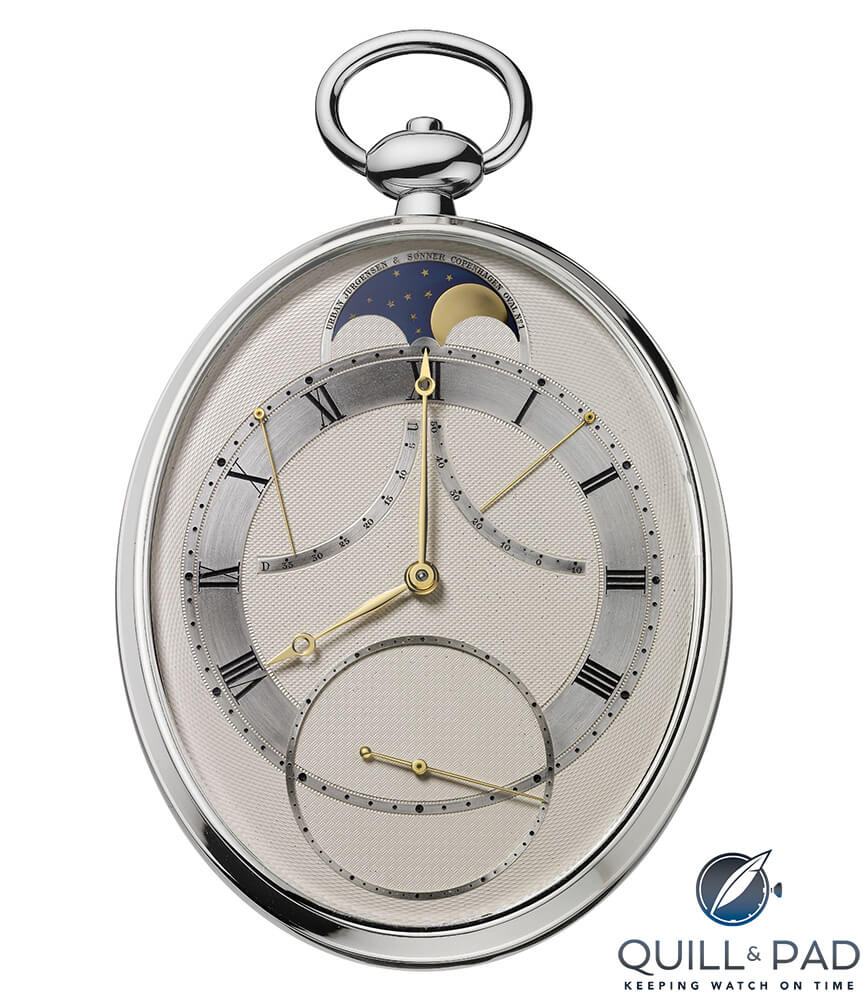
Front view of the Urban Jürgensen oval tourbillon pocket watch from 1991 by Derek Pratt in its original silver case; Pratt engine-turned the dial made from a single piece of silver by hand himself
Fascinated by the idea of developing an escapement requiring no lubrication, Pratt also pursued the concept of Abraham-Louis Breguet’s échappement naturel in 1997 – a date coinciding with the anniversary of the famous watchmaker’s 250th birthday. He debuted this it in a pocket watch tourbillon with double remontoir escapement delivering impulses in two directions and needing no lubrication.
Pratt was a close friend to George Daniels for many years, and Treffry noted in the BHI proceedings’ introduction that the two had long phone conversations mostly every week. “He was also actively involved with George in his efforts to get the Swiss industry to adopt the coaxial escapement and became an important intermediary when Omega was adapting it for mass production. Derek produced the escape pinion for the ‘thin’ version of the escapement and made a number of wheels for Daniels watches.”
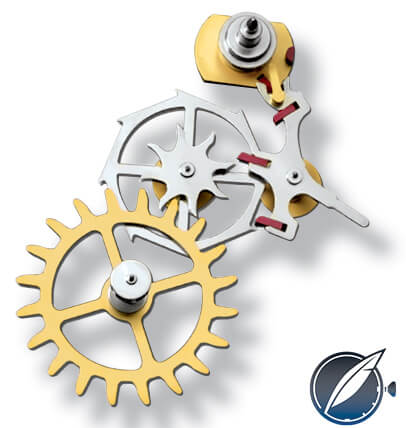
The George Daniels coaxial escapement
Obituary remarks by George Daniels
Daniels wrote extensive obituary remarks that were published in the BHI’s Horological Journal. Here is an excerpt of the most poignant of them.
“His pocket tourbillon chronometers are exquisitely made and finished and are now in the hands of some of the most knowledgeable horologists to be found in Europe. His work was almost always made by hand methods because he enjoyed the feel of the tools and the freedom of introducing alterations as he worked. His workshop was innocent of CAD and repetitive tooling. Serious horologists were always welcome to see and discuss his methods.
“When not engaged on his own work, he would design and make prototype mechanisms for the benefit of less able commercial makers who wanted to decorate their dials with subsidiary information. Given the tools, Derek could make anything that attracted his interest. One of his early triumphs aided the production of micro-circuits for the fledgling semi-conductor industry. At the other end of the scale were his ingenious water clocks that were his invention and now serve as public clocks in some surrounding Swiss villages.
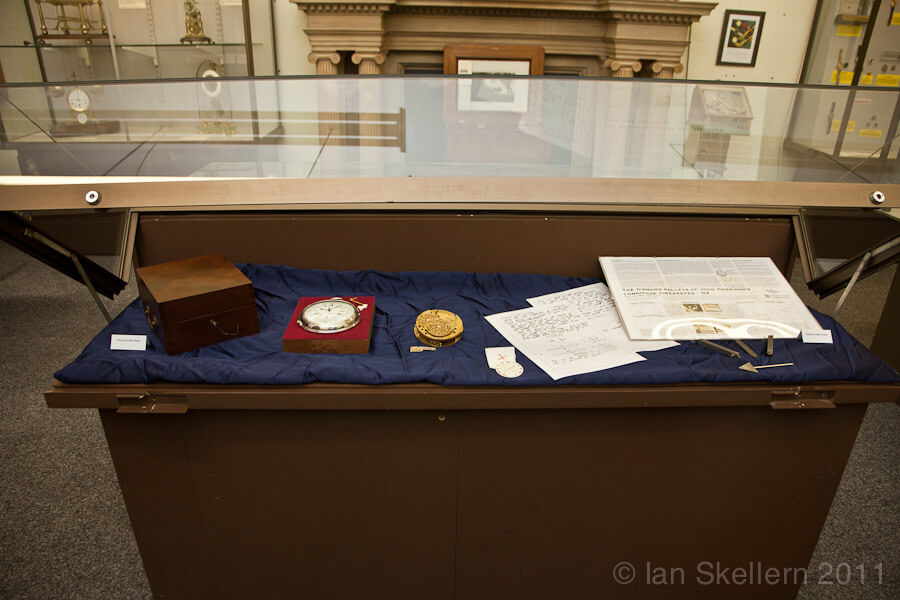
Derek Pratt’s unfinished H4 replica on display at the commemorative seminar held in 2011 at the British Horological Institute’s Upton Hall
“Derek’s understanding of escapements was of great assistance to me. He immediately saw the benefit of the co-axial escapement and enthusiastically accompanied me in visiting factories to discuss its worth. He could speak French and Swiss German fluently, which was essential to our needs. We would take to the road early in the morning with coffee (and some brandy to relieve the cold) and spend the day discussing escapements with largely uncomprehending R&D departments. Derek’s final choice of escapement was the double impulse chronometer, to which he added an ingenious remontoir, to finalize the development of a beautifully unique and complex work of art. I am delighted that Derek chose my escapement to demonstrate his power of original thought.
“Among his more relaxing activities he used a nineteenth-century Dursley-Pedersen bicycle and a hundred year old ‘ordinary’ (Penny Farthing). For longer distances he favored a 1000cc BMW motorcycle, upon which he looked rather dangerous. The machine was too big for him; when sitting on the saddle his feet could not reach the ground.
“With Derek’s passing we have all lost an important mechanical horologist of great experience and great knowledge, who was above all generous and congenial in his dealings with others. I have simply lost a brilliant horological friend and companion.”
The unfinished John Harrison H4 replica
Pratt famously began, but unfortunately died before he could finish, a replica of John Harrison’s H4.
He began the project in 1997 with years of research. By the time Frodshams took over, another four years were needed to complete it – and it was done in time for the “Ships Clocks and Stars” exhibition at the National Maritime Museum in Greenwich in March 2014.
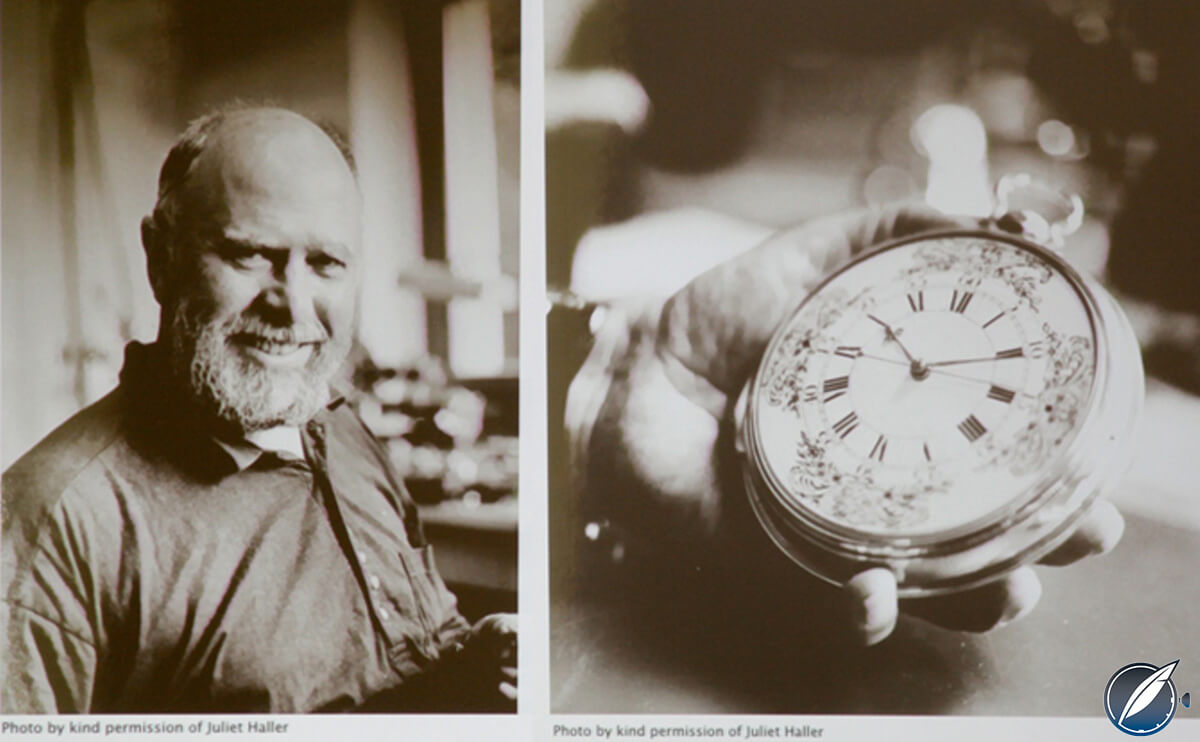
Derek Pratt next to his replica of John Harrison’s H4, which he unfortunately did not live to see completed (original photos courtesy Juliet Haller)
In a nine-day static test, Pratt’s H4 achieved ±2 seconds/day. This is well within the ±2.8 seconds/day average required on a six-week voyage to the West Indies to qualify for the Longitude Prize, by the way.
The piece is currently traveling in an exhibition by the British National Maritime Museum in Greenwich.
A video produced by Barbara Darby sees Pratt narrating a study of his H4 replica. The video was shown at the BHI’s 150th anniversary celebrations, which Pratt was too ill to attend. Darby donates all profits from the sale of the full video to Prostate Cancer UK.
“Apart from the H4 project, Derek made a number of beautiful and ingenious pocket watches, some with remontoir tourbillons. One used a Reuleaux triangle and another the Daniels double-wheel escapement: the escape pinions engage the inward and outward facing teeth on the fixed fourth wheel. As they are driven around it by the rotation of the tourbillon, each turn in a different direction and can impulse the balance both ways,” Treffry recently told me.
“As well as magnificent watches he also made a number of innovative clocks; including two substantial water-powered feature clocks, one displayed in Switzerland and another at the BHI headquarters in the UK.”
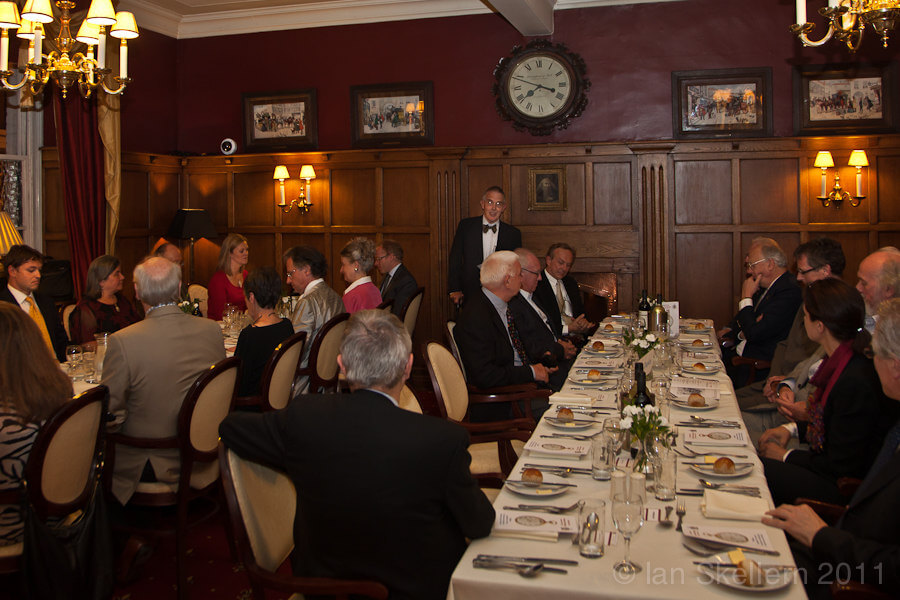
At the 2011 Derek Pratt commemorative dinner with Timothy Treffry speaking
He additionally studied and prototyped the use of a constant force Tensator mainspring in watches (see an example in Oscillon’s l’Instant de Vérité: The Most − If Not The Only − Fully Handmade Watch Available Today − Felix Baumgartner And Time Aeon Foundation Are Involved). Pratt was also heavily involved in developing his own wristwatch before his untimely death, a project that continues.
Pratt died after a long, severe fight with prostate cancer in 2009. An extensive memorial seminar took place on September 18, 2011 at the BHI’s Upton Hall; many of the world’s leading horologists were in attendance (as was our own Ian Skellern).
Pratt earned a number of awards throughout his lifetime including Freeman of England’s Worshipful Company of Clockmakers (1979), Liveryman of the society (1982), silver medal of British Horological Institute (1992), the MIH’s Prix Gaïa for artisanal creation (1999), and the Tompion gold medal of the Worshipful Company of Clockmakers (2005).
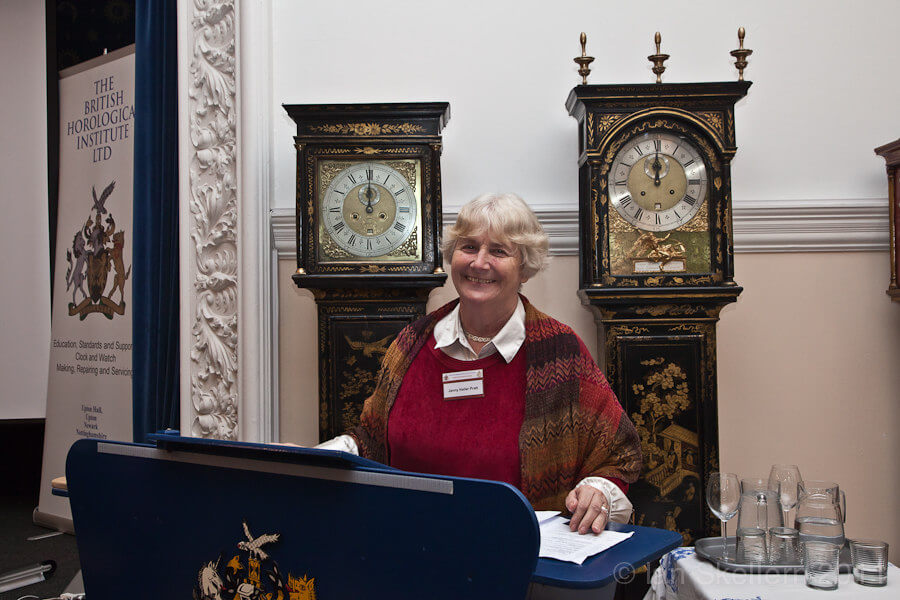
Jenny Haller Pratt speaking at the 2011 Derek Pratt commemorative seminar at the BHI’s Upton Hall
Along with his wife, Jenny Haller Pratt, he also translated several books on horology over the course of his life and collaborated on translating George Daniels’ Watchmaking into French. He also authored a number of articles for the BHI Horological Journal.
“Derek’s main feature was that, as well as an astonishingly skilled and inventive craftsman, he was a very nice guy who respected and admired the work of others,” Treffry remembers.
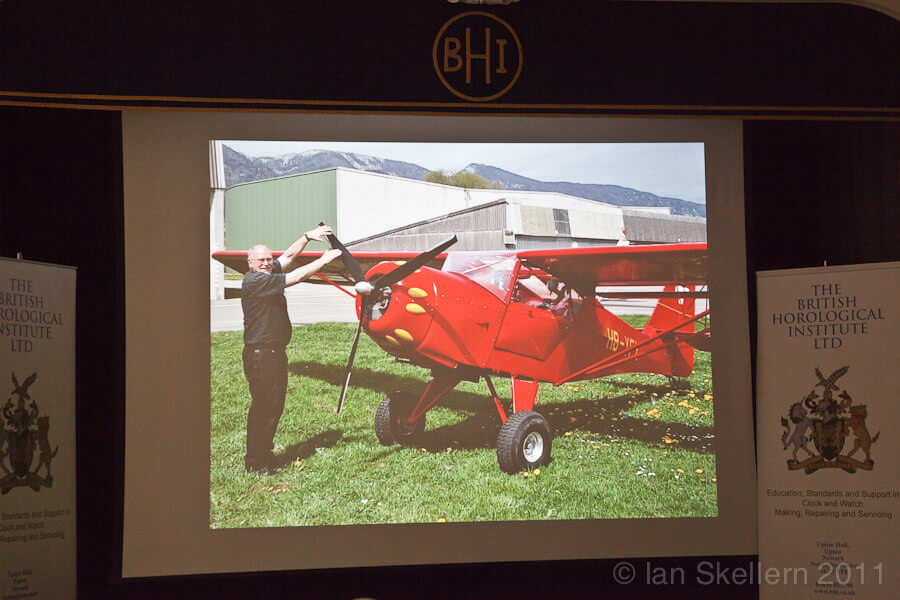
A man of many talents, Derek Pratt also loved flying as evidenced in this slide from the 2011 BHI commemorative seminar
Antiques expert and previous Urban Jürgensen owner Helmut Crott calls him one of the most important and outstanding watchmakers of our times. “I personally knew and appreciated Derek as a warm-hearted person and passionate lover of fine watches as well as a scientist in horology. He was a dedicated watchmaker, who took great care in the traditional quality of the manufacture of watches with an emphasis on detail and sustainability,” he said.
You may also enjoy:
Trackbacks & Pingbacks
-
[…] Derek Pratt […]
-
[…] and artistic virtuosos that include the likes of François-Paul Journe, Michel Parmigiani, Derek Pratt (who co-created many Urban Jürgensen recent-history works), George Daniels, Beat Haldimann, […]
-
[…] Past laureates in this category include the likes of François-Paul Journe, Michel Parmigiani, Derek Pratt (who co-created many Urban Jürgensen recent-history works), George Daniels, Beat Haldimann, […]
-
[…] learn more about Derek Pratt please see The Life And Times Of Legendary Independent Watchmaker Derek Pratt, Derek Pratt’s Reconstruction Of John Harrison‘s H4, The World’s First Precision Marine […]
-
[…] learn more about Derek Pratt please see The Life And Times Of Legendary Independent Watchmaker Derek Pratt and for part 1 in this series click Derek Pratt’s Reconstruction Of John Harrison‘s H4, The […]
-
[…] For a fuller biography, please see The Life And Times Of Legendary Independent Watchmaker Derek Pratt. […]
Leave a Reply
Want to join the discussion?Feel free to contribute!



Wonderful article!
Thank you for remembering Mr Pratt, who I feel does not get enough recognition for his truly astonishing talent.
I’ve been creating a website of Barbara Darbys films as digital downloads. Focusing on the work of Martin Matthews (my grandfather) but also Derek Pratts reconstruction of the H4. If anyone wants to purchase the film for download or dvd please visit: https://martinmatthewswatchcasemaker.com/
Thank you for the link